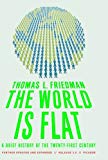
The World Is Flat is a book by Thomas Friedman discussing the trends of globalization in the 21st century. Friedman describes himself as a "free-trader," arguing in favor of the rapid shifts towards a more interconnected economic world after the fall of the USSR as a result of the Internet, computers, outsourcing and workflow software. Friedman also presents his controversial Dell Theory of Conflict Prevention: that corporations' increased dependency on foreign labor and resources will prevent armed conflict.
Thomas Friedman’s examination of the influences shaping business and competition in a technology-fueled global environment is a call to action for governments, businesses and individuals who must stay ahead of these trends in order to remain competitive.
In a narrative punctuated by case studies, interviews and sometimes surprising statistics, Friedman’s message is clear: be prepared, because this phenomenon waits for no one. Without rhetoric or scare tactics, he paints a picture of a world moving faster than most can keep up. As we explore America’s place in the fast-evolving world economic platform, Friedman presents not only the problems we face, but preventative measures and possible solutions.
The World is Flat is an historical and geographical journey, with stories and anecdotes from the days of Columbus to a modern day Indian call center; from the Great Depression to the home office of a Midwestern-USA housewife demonstrating the pervasiveness of the world-flattening trend. Spanning a broad range of industries, cultures and schools of thought, the real-world examples presented as evidence of his theory are undeniable.
From teleconferencing to podcasts and manufacturing to restaurant order taking, The World is Flat leaves no stone unturned in a quest for answers to a problem that most cannot even define. Friedman’s dissection of globalization is a valiant attempt at explaining and understanding the forces driving the flattening of the world, though he admits that the very nature of beast prevents one from having all of the answers. This candor is in keeping with the theme of the entire book, in that we must learn how to learn, teaching ourselves to stay curious and innovative, if we are to excel in a global economy.
As he moves towards the end of this presentation of his theory, Friedman warns of the forces that could seriously harm or slow the flattening of the world, particularly the threat posed by terrorist networks such as Al-Qaeda. His perspective is refreshing in a media driven largely by scare tactics and fear mongering as he encourages a realistic and objective approach to this threat.
As people become more able to collaborate, compete and share with others of different cultures, religions, educational backgrounds and languages, The World is Flat is a necessary reality check to bring these factors into perspective and offer, if not answers to every problem, the drive to uncover working solutions.
Already have an account? Log In Now